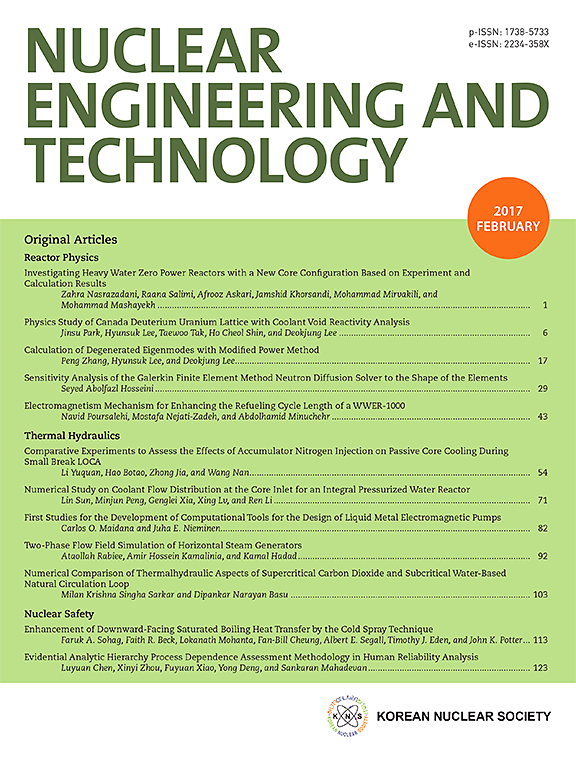Corrosion studies of Inconel 617 in high temperature air and He-ppmO2 atmospheres
IF 2.6
3区 工程技术
Q1 NUCLEAR SCIENCE & TECHNOLOGY
引用次数: 0
Abstract
Air ingress accident is one of the typical accident conditions in Very High Temperature Reactors (VHTRs). This work investigates the oxidation kinetics, corrosion behavior and mechanism of Inconel 617 alloy in different oxygen concentration atmospheres under air ingress accident. The impact of O2 concentration and oxidation time of the alloy corrosion is investigated. A gas chromatograph was used to measure the impurity content in real time during the helium experiments. After the experiments, the alloys were characterized by electronic balance, were analyzed by Scanning Electron Microscopy (SEM), Energy-Dispersive X-ray Spectroscopy (EDS), X-ray diffraction (XRD) and carbon and sulfur analyzer. The results show that: the Inconel 617 alloy undergoes similar oxidation behavior and the degree of oxidation is very close in three groups of atmospheres with large differences in oxygen content; the alloy should show two oxidation mechanisms, linear oxidation and parabolic oxidation, during the oxidation process; the parabolic rate constant and of the alloy is a constant value and does not vary with large changes in oxygen concentration, but when the experimental temperature changes, the oxidation rate constants of the alloy change, and the lowering of the temperature leads to the lowering of the oxidation rate constants; When experimental temperature is at 950 °C, the alloy continues to undergo a “microclimatic reaction” in the atmosphere of He-ppmO2, and the microclimatic reaction disappears when the experimental temperature is lowered to 750 °C; In He-ppmO2 environment, gas chromatograph can be used instead of thermogravimetric analyzer for real-time monitoring.
高温空气和 He-ppmO2 气体环境中 Inconel 617 的腐蚀研究
进气事故是超高温反应堆(VHTR)的典型事故条件之一。本研究探讨了 Inconel 617 合金在不同氧浓度气氛中发生进气事故时的氧化动力学、腐蚀行为和机理。研究了氧浓度和氧化时间对合金腐蚀的影响。在氦气实验过程中,使用气相色谱仪实时测量杂质含量。实验结束后,用电子天平对合金进行了表征,并用扫描电子显微镜(SEM)、能量色散 X 射线光谱(EDS)、X 射线衍射(XRD)和碳硫分析仪进行了分析。结果表明在氧含量差异较大的三组气氛中,Inconel 617 合金的氧化行为相似,氧化程度非常接近;合金在氧化过程中应呈现线性氧化和抛物线氧化两种氧化机理;合金的抛物线速率常数和是一个恒定值,不会随氧浓度的大幅变化而变化,但当实验温度变化时,合金的氧化速率常数会发生变化,温度的降低会导致氧化速率常数的降低;当实验温度为 950 ℃ 时,合金在 He-ppmO 气氛中继续发生 "微气候反应",当实验温度降低到 750 ℃ 时,微气候反应消失;在 He-ppmO 环境中,可使用气相色谱仪代替热重分析仪进行实时监测。
本文章由计算机程序翻译,如有差异,请以英文原文为准。
求助全文
约1分钟内获得全文
求助全文
来源期刊

Nuclear Engineering and Technology
工程技术-核科学技术
CiteScore
4.80
自引率
7.40%
发文量
431
审稿时长
3.5 months
期刊介绍:
Nuclear Engineering and Technology (NET), an international journal of the Korean Nuclear Society (KNS), publishes peer-reviewed papers on original research, ideas and developments in all areas of the field of nuclear science and technology. NET bimonthly publishes original articles, reviews, and technical notes. The journal is listed in the Science Citation Index Expanded (SCIE) of Thomson Reuters.
NET covers all fields for peaceful utilization of nuclear energy and radiation as follows:
1) Reactor Physics
2) Thermal Hydraulics
3) Nuclear Safety
4) Nuclear I&C
5) Nuclear Physics, Fusion, and Laser Technology
6) Nuclear Fuel Cycle and Radioactive Waste Management
7) Nuclear Fuel and Reactor Materials
8) Radiation Application
9) Radiation Protection
10) Nuclear Structural Analysis and Plant Management & Maintenance
11) Nuclear Policy, Economics, and Human Resource Development
 求助内容:
求助内容: 应助结果提醒方式:
应助结果提醒方式:


